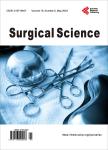Males at High Risk for Breast Cancer: Who Are They and How Should We Screen Them?
Males at High Risk for Breast Cancer: Who Are They and How Should We Screen Them?作者机构:Department of Surgery Saint Barnabas Medical Center Livingston USA Saint George’s University School of Medicine Grenada West Indies
出 版 物:《Surgical Science》 (外科学(英文))
年 卷 期:2014年第5卷第7期
页 面:320-331页
学科分类:1002[医学-临床医学] 100214[医学-肿瘤学] 10[医学]
主 题:Male Breast Cancer Risk Factors Carcinoma of the Male Breast Breast Carcinoma
摘 要:Background: It is estimated that 2240 males in the United States will develop invasive breast cancer (BC) in 2013, resulting in 410 deaths. Overall, male breast cancers (MBCs) are diagnosed with larger tumor size, more frequent lymphatic invasion, and advanced tumor stage compared to their female counterparts. Several risk factors have been elucidated for the development of MBC, and this paper aims to critically review the existing literature on at-risk populations and provide screening recommendations. Methods: A comprehensive search for all published studies on populations at risk for MBC using PubMed, EBSCOhost, and Google Scholar was performed (1982- 2013). The search focused specifically on genetic and epidemiologic risk factors, and screening for MBC. Keywords searched included “male breast cancer risk factors, “male breast cancer epidemiology, and “male breast cancer genetics. A total of 34 studies involving 4,865,819 patients were identified. Results: Five studies (N = 327,667) focused primarily on family history of breast cancer as a risk factor for MBC. 15% - 20% of men with BC have a family history of breast or ovarian cancer, and a family history of BC among first-degree relatives confers a 2-to 3-fold increase in MBC risk (odds ratio = 3.3). Seventeen studies (N = 5451) analyzed associations between several heritable genes and MBC. Lifetime MBC risk among BRCA1 mutation carriers is 1% - 5%, while MBC risk in BRCA2 mutation carriers is higher and varies between 4% - 40%. Less clear associations between MBC and PALB2, Androgen Receptor gene, CYP17, and CHEK2 mutations have also been documented. Five studies (N = 16,667) have addressed occupational risk factors for MBC. An 8-fold increase in MBC is reported in males working in the cosmetic cream manufacturing, and the motor vehicle industries. A meta-analysis of 18 trials also identified electromagnetic field exposure as a potential MBC risk, though causation remains undocumented. Eleven studies (N = 4,



